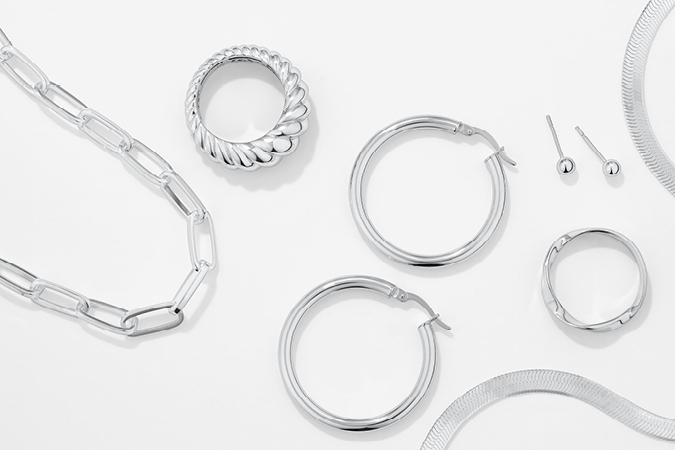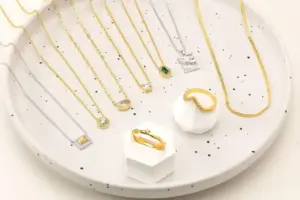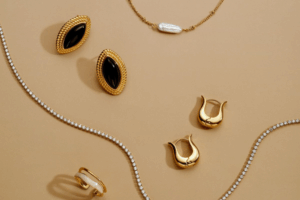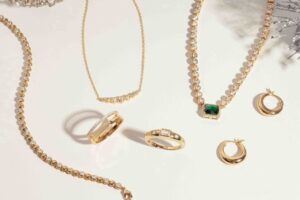Rhodium and Sterling Silver are two reliable metallic components used to enhance the overall appearance of jewelry pieces. While they have closely-related features, they are different in various ways.
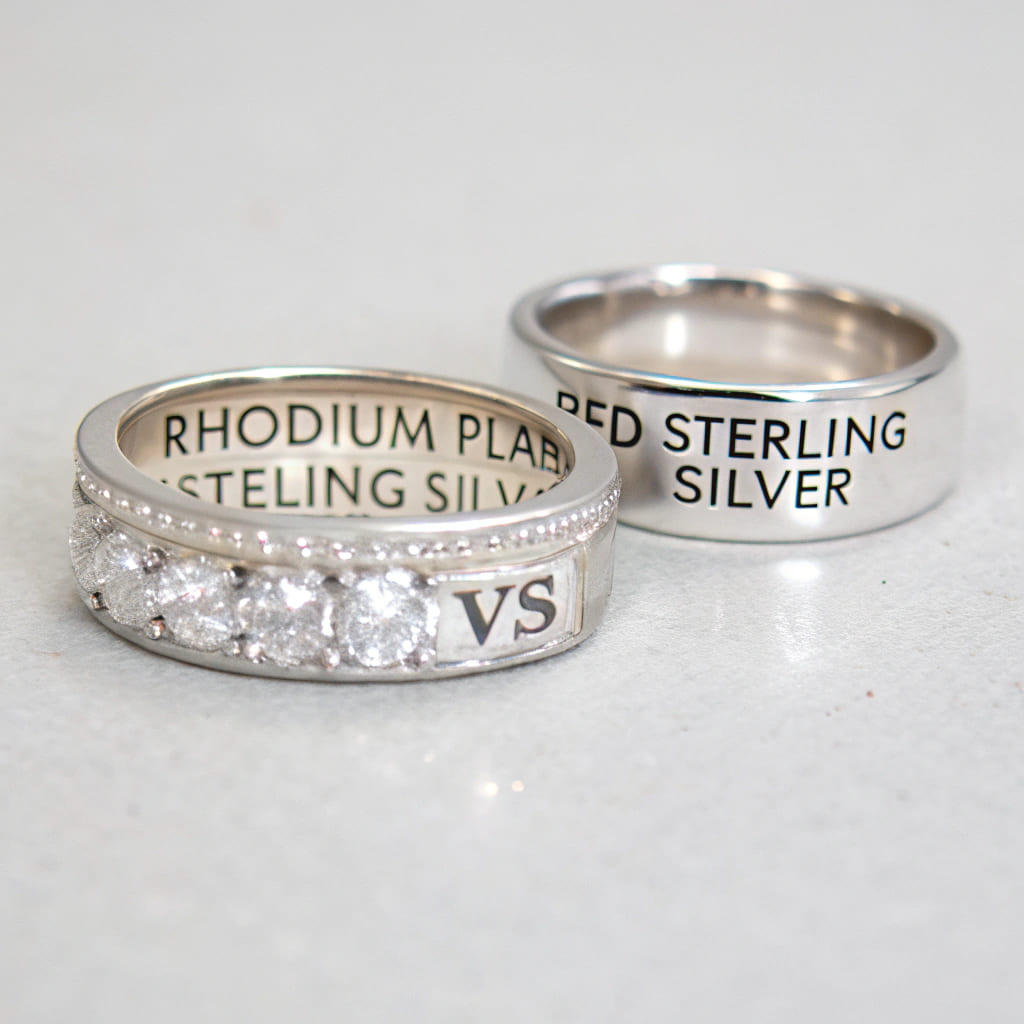
In this article, we will give a detailed rhodium plated sterling silver vs sterling silver comparison, discussing their pros, cons, differences, and helping you choose the better option of rhodium plated vs sterling silver.
What is Rhodium Plated Sterling Silver?
This is a sterling silver base metal that is coated with rhodium. Rhodium is one of the rarest and most expensive metals used for making jewelry. It is a strong, shining metal that adds an extra layer of durability and a captivating look to sterling silver pieces.
Why is Sterling Silver Rhodium Plated?
Sterling silver is good on its own, however, coating it with rhodium enhances its durability and gives it:
- A shiny texture that disguises any imperfections on the sterling silver.
- A hypoallergenic feel that prevents skin reactions.
- A higher scratch-resistance that’s less prone to tarnishing.
- A bright and high luster appearance.
Process for Rhodium Plating
A durable and high-quality rhodium plating can be achieved following the 12 steps listed below:
- Firstly, polish the base metal to create a high gloss finish.
- Clean the surface thoroughly with an ultrasonic cleaner to remove oils, dirt, and impurities.
- Rinse with distilled water to eliminate any residual cleaning solution.
- Steam clean to ensure it’s completely free of contaminants.
- Electro-clean the jewelry in a solution at 120°F, using 4 volts for 2 minutes.
- Rinse thoroughly with clean distilled water.
- Apply an activator solution at room temperature for 30 seconds without voltage.
- Rinse out residues with clean distilled water.
- Dip in fresh distilled water till the surface becomes clear enough.
- Commence rhodium plating at room temperature by applying 4.5 volts for 20-30 seconds.
- Rinse again with clean distilled water (hot distilled water dries faster).
- Steam clean with a drier or soft tissue.
Note: In case you find these procedures complicated, do not hesitate to contact a sustainable jewelry manufacturer.
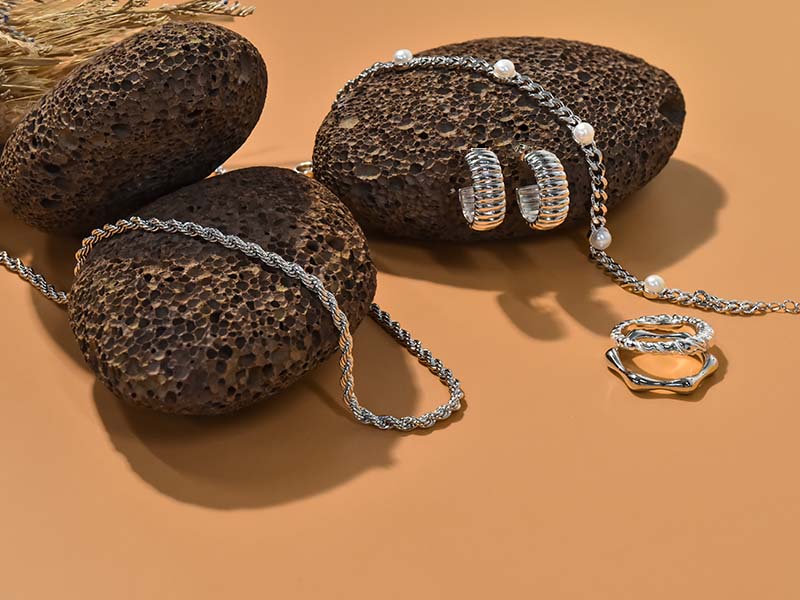
Pros of Rhodium Plated Sterling Silver
- High-shine Finish: Sterling silver plated with rhodium maintains a mirror-like shine for a longer period. The rhodium plating creates a reflective feel that makes the jewelry appear brighter.
- Exceptional Durability: Rhodium plating provides an extra layer that protects jewelry pieces from wear and tear. This makes them last longer when compared to metals without plating.
- Hypoallergenic: Rhodium is one of the Platinum Group Metals (PGM) and they contain little to no nickel alloy that can trigger allergic reactions.
- Scratch-resistant: Rhodium’s low density makes sterling silver plating smooth and highly resistant to scratch, dent, or other surface damage.
- High Value: Jewelries plated with rhodium have high value because of how rare they are and the popularity of their demand.
Cons of Rhodium Plated Sterling Silver
- Higher Price: Rhodium is one of the most expensive metals that exists therefore, rhodium-plated jewelry is often priced higher than jewelry made of gold or silver.
- Complex Plating Process: Coating sterling silver with rhodium involves a complex process that can only be executed by only a professional rhodium plated sterling silver jewelry manufacturer.
- Requires Re-plating required: As durable as rhodium plating is, its surface is capable of wearing off when it is frequently exposed to harsh conditions. This results in the need to re-plate frequently as it occurs.
What is Sterling Silver?
Sterling silver is a metal component that contains 92.5% silver and 7.5% other metals (usually copper or zinc), which can be considered nickel free jewelry. Other metals are often added to make the jewelry more durable because pure silver is extremely malleable and isn’t strong enough.
Sterling silver often carries a 925 stamp, which is an indication of its authenticity. The mark can be used to tell the difference between silver and sterling silver.
Pros of Sterling Silver
- Low Cost: Sterling silver is one of the cheapest and available precious metal components. It is often made into several types of jewelry at consumer-friendly prices.
- Flexible: Working on sterling silver is quite easy due to the malleability of pure silver. This creates a flexible texture that can be used to produce intricate jewelry pieces.
- Traditional and Classic Look: Sterling silver is highly sought after for the classy aesthetic it introduces to outfit. It has been utilized throughout history as a traditional way of fashion expression.
Cons of Sterling Silver
- Prone to Tarnish and Less Durable: When non-plated sterling silver gets frequently exposed to elements like chemicals, moisture, or sulfur; oxidation occurs and this causes it to tarnish and be less durable over time.
- Requires Regular Maintenance: Being a soft metal, sterling silver is highly susceptible to dents and scratches that may require periodic maintenance.
Rhodium Silver vs Sterling Silver: What’s the Differences?
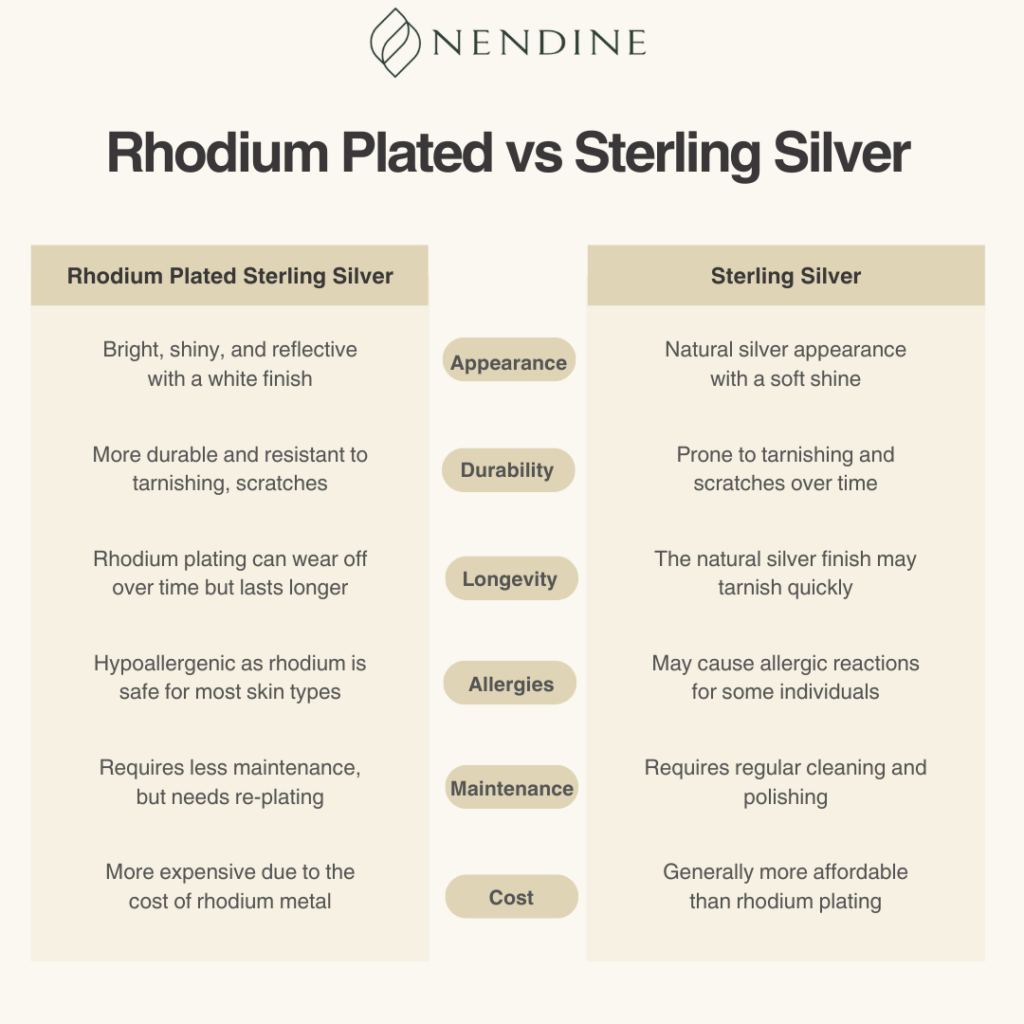
Below is a detailed comparison of rhodium silver vs 925 sterling silver, highlighting their individual characteristics.
Appearance and Aesthetics
- Rhodium Silver: Rhodium-plated silver has a bright white finish with reflective shine and luster that’s similar to white gold.
- Sterling Silver: This is a soft shiny metal with pale white color. Its texture exudes a nostalgic feel that brings harmony to the skin.
Durability and Maintenance
- Rhodium Silver: Due to its purity, rhodium-plated silver does not wear off easily. The smooth surface layer gives it additional protection from scratch and creates room for future re-plating.
- Sterling Silver: Its durability depends on the frequency of use and the conditions it gets exposed to. Over time, its surface begins to tarnish, but it’s easy to maintain.
Hypoallergenic Properties
- Rhodium Silver: Rhodium plated jewelry is a great option for those with sensitive skin. Rhodium is applied in its purest form, free from allergies like nickel that may trigger allergies.
- Sterling Silver: May have allergic reactions for people with sensitive skin due to the alloy composition of various metals, such as copper, zinc, etc.
Price and Value
- Rhodium Silver: As of early 2025, rhodium is valued at $4,650 per OZ. This makes it the most-priced metal that exists, but it pays with its good quality.
- Sterling Silver: When compared to rhodium, sterling silver is quite cheap. It is much more available and the value can be influenced by the type of jewelry it is made into.
So, Which is Better: Rhodium Plated or Sterling Silver?
Deciding whether sterling silver or rhodium plated jewelry is better depends on the qualities you’re looking for.
If durability and low maintenance are your priorities, rhodium plated sterling silver has the advantage. The rhodium layer acts as a protective barrier, making the surface more resistant to scratches, tarnish, and everyday wear. It also gives the jewelry a brighter, mirror-like white finish that many people love.
On the other hand, if you value authenticity, purity, and long-term intrinsic value, non-platedsterling silver is the better choice. It offers the natural luster of silver and can be polished repeatedly to restore its shine over time. Sterling silver is also ideal for those who prefer a classic, timeless look without additional plating layers.
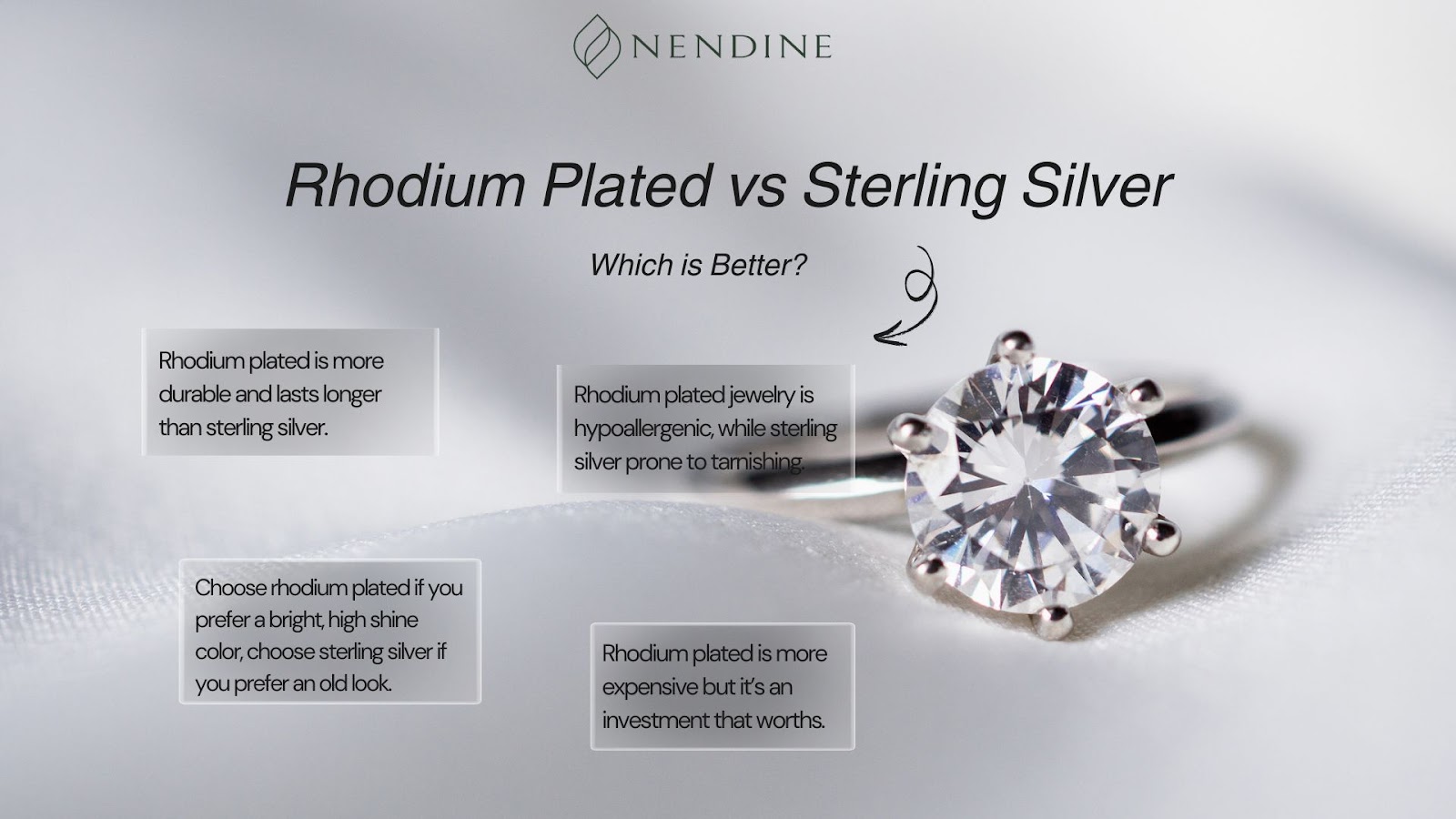
Choosing the Right Option For Your Jewelry Line
Choosing the appropriate metal for your jewelry line should be done after considering the factors listed below:
Your Design & Style
Those who prefer the old and antique look should not choose rhodium. It is recommended to use rhodium plating over products like rings and necklaces that are naturally more prone to wear and tear due to longer use and frequent contact with sweat and chemicals. Rhodium plating extends jewelry lifespan, even if they are worn daily.
Your Budget
There is a big difference between rhodium vs silver price therefore, the budget you set aside will greatly influence the metal you’ll get. Rhodium is rarer and more expensive. Sterling silver, on the other hand, is more available and budget-friendly.
Customer Preference & Target Market
Another thing to consider is the type of market for your product. If your customers are lovers of luxurious aesthetics, you should stock more rhodium plated sterling silver pieces. If they are average-income earners who want to style on a budget, sterling silver is best.
Does Rhodium Plated Sterling Silver Tarnish?
No, rhodium plated jewelry is not prone to tarnish. It provides a tarnish-resistant layer that protects the silver underneath. Over time, if the plating wears off, the underlying silver may tarnish—but this can be restored through re-plating.
Is Rhodium Plated Sterling Silver Waterproof?
Yes, rhodium plated jewelry is water-resistant and can handle everyday moisture or occasional swimming. However, frequent contact with chlorine, salt water, or harsh chemicals may wear off the plating. Rinse and dry well after exposure to keep it lasting longer.
How Long Does Rhodium Plated Sterling Silver Last?
Rhodium plating typically lasts 1–2 years with regular wear. Its longevity depends on usage frequency, exposure to chemicals, and body chemistry. Rings and necklaces pieces may require more frequent re-plating.
Will Rhodium Plated Sterling Silver Turn Your Finger Green?
No, rhodium-plated sterling silver typically won’t turn your skin green. The rhodium layer acts as a protective barrier between your skin and the silver, preventing oxidation. This makes it a great option for sensitive skin.
Can You Wear Rhodium Plated Jewelry in the Shower?
Yes, it’s generally fine to wear rhodium-plated jewelry in the shower, as it resists everyday moisture. It is one of the types of jewelry you can wear in the shower. However, prolonged exposure to water, soap, and personal care products can speed up plating wear. To keep it in good condition, gently wipe and dry it afterward.
Is Rhodium Plated Sterling Silver Good?
Is Rhodium Over Sterling Silver Worth Anything? Absolutely. Rhodium-plated silver combines the affordability of sterling silver with the premium shine, durability, and hypoallergenic properties of rhodium. For jewelry brands and wearers seeking a high-end look, it offers excellent value and lasting appeal.
How to Clean Tarnished Sterling Silver?
Use a soft silver polishing cloth regularly. For heavier tarnish, use mild silver-cleaning solutions and avoid harsh chemicals. Check our guide on how to clean and care for sterling silver jewelry to learn more.
Key Takeaway
Rhodium plated vs sterling silver jewelry are fashion staples that meet both luxurious and basic needs. They have certain distinctions, such as their appearance, durability, hypoallergenic properties, and price that give room for you to choose which is a better option.
